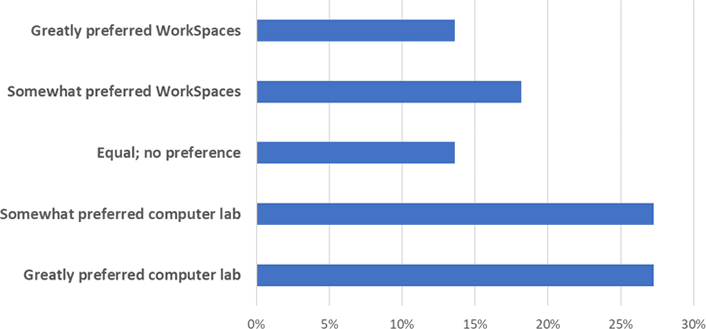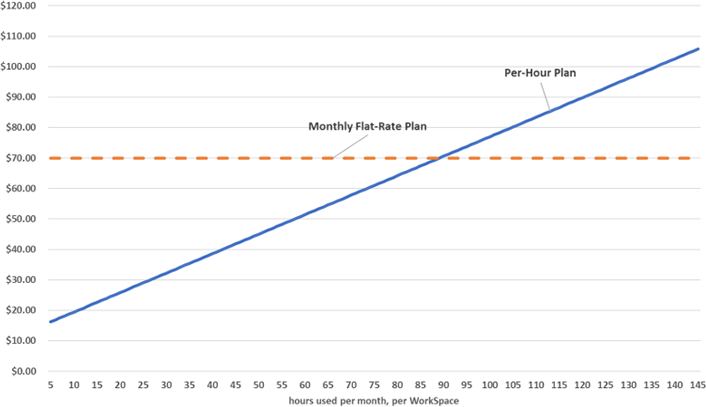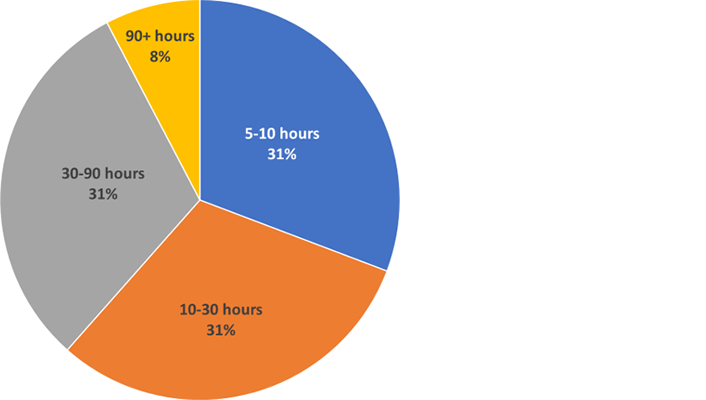Increasing market demands for data analytics skills are producing a greater need for hands-on analytics coursework; this, in turn, is dramatically increasing high-end computing requirements at many institutions. To address this, one university extended its desktop environment to the cloud, deploying preconfigured environments that are accessible on personal devices and from a distance.

In 2014, then-governor Terry McAuliffe challenged Virginia's state universities to produce a higher number of graduates with skills in data analytics. At the University of Virginia's McIntire School of Commerce, this push—combined with market forces demanding the same skill sets—created a remarkable increase in hands-on technical course work in data analytics methods and techniques. Data analytics methods and the associated software tools are now integrated into each of the school's five undergraduate business concentrations and the master's in commerce degree program. Further, the exploding corporate demand for these competencies led the school to launch a new executive master's in business analytics (MSBA) in fall 2018.
These curriculum innovations have markedly increased the school's computing requirements. Physical computing labs, long in decline at the university level, have expanded in both seating capacity and computing power over the past four years. Further, as physical lab seating reached maximum capacity and support needs increased for students in distance-based programs, McIntire began exploring options to extend desktop environments beyond the physical labs on the school's Charlottesville grounds.
Potential Solutions
To support these efforts, one of the first options considered was to set baseline hardware specifications and require students to install programs on their personal devices. However, the software packages used in data analytics courses are heavily Windows-based, which would have created significant challenges in deploying software directly to student-owned hardware in McIntire's majority-Mac BYOD student environment. Successfully deploying Windows software packages would require an individual virtualization solution (such as VirtualBox or Parallels Desktop) on each student MacOS device, adding overhead and additional challenges. Further, students carry a wide variety of hardware, which could lead to significant inconsistencies in the user experience when processing large data sets. Ultimately, this approach was discounted due to these factors and the associated support and time costs.
Another option considered was to issue pre-imaged Windows laptops for master's level students. Ultimately, however, the program could not absorb the costs associated with this effort; also, similar approaches in the past had proven highly unpopular with students (many of whom already have personal Windows-based laptops more than capable of running the required software packages).
The school also considered using the University of Virginia's centralized VMware environment, known as The Hive, but the inability to customize the desktop environment with the necessary software made this approach unusable. McIntire had previously taken preliminary steps to deploy its own in-house Microsoft desktop-as-a-service (DaaS) environment, but repeated issues with stability and performance derailed the project in 2015.
Ultimately, McIntire selected Amazon WorkSpaces as the DaaS solution for the school. WorkSpaces is a cloud offering for always-on or hourly billed customizable virtual desktop environments offered as part of the larger Amazon Web Services (AWS) portfolio. A 2016 EDUCAUSE Annual Conference presentation from the University of Maryland University College showed the potential benefits at scale of this product offering.1 The service was particularly attractive due to the platform-agnostic client available for Windows, MacOS, Linux, ChromeOS, iOS, and Android devices. In addition, McIntire runs programs in multiple locations around the country, so a cloud-based solution was deemed preferable to something completely reliant on the Charlottesville infrastructure.
McIntire began working with Amazon in 2016 to set up an environment to support students within the existing programs as well as in the forthcoming MSBA program. Several contractual and infrastructure pieces had to be put into place before the first workspace was launched. Because both AWS and UVA participate in Internet2 agreements, the procurement process is greatly simplified.
McIntire wanted to use database and file server resources in Charlottesville as well as domain management of the DaaS PCs to allow features such as group policy control and single sign on (SSO), which required network team involvement to create secure connections to an Amazon virtual private cloud (VPC) environment. Ensuring correct configuration, routing, and IP address space usage for the WorkSpaces required careful coordination with the network team.
Piloting Amazon WorkSpaces
Building on lessons learned from a fall 2017 pilot, McIntire began work on a larger rollout for spring 2018. This pilot was built using Amazon's "bring your own license" (BYOL) WorkSpaces model. The team created a Windows 10 image and validated it against UVA's own Microsoft key management server. Using BYOL allowed for the use of a true desktop operating system and UVA-licensed Microsoft Office, reducing concerns about software compatibility and lowering usage costs by eliminating the need to pay Amazon for Microsoft products already covered by a site license.
Moving to a BYOL image in WorkSpaces is a time-consuming process. AWS must vet the image before it can be used, and it took approximately six weeks from the time the team submitted the image until it was approved and available in the AWS console.
Using the AWS reporting interface, the team tracked usage across the two semesters of the WorkSpaces pilot. On average, students used WorkSpaces for roughly ten hours per semester, with outliers at both ends of the spectrum: about five percent used the service for less than four hours per semester, while roughly ten percent used it for fifteen hours or more.
At the conclusion of each term, the team surveyed students from each of the four courses about their experiences with WorkSpaces (see figure 1). For these two semesters, student access to WorkSpaces was optional.

All of the applications installed in WorkSpaces were also available in McIntire's physical computer labs. Lab computers feature twenty-one-inch monitors, and one-third have dual screens. Many students who preferred using the lab PCs specifically cited screen size and quantity as a factor. Other students indicated that the limited software base for the pilot WorkSpaces prevented them from using it but that they would use WorkSpaces in the future if the number of applications increased (see figure 2).

Moving Amazon WorkSpaces into Production
For the fall 2018 semester, McIntire's WorkSpaces usage moved from pilot to production. Although a group of WorkSpaces for undergraduate use was maintained, the school's mission-critical focus for this semester was the new MSBA. This hybrid program—online and distance-based—comprises students living and working in northern Virginia, Maryland, and Washington, DC (two or more hours away from the UVA grounds).
MSBA program students do not have regular access to McIntire's physical computer labs and are required to use resource-intensive Windows-based analytical software, such as SPSS and Crystal Ball. The program's faculty requested that these WorkSpaces be built using Amazon's highest available hardware bundle. The Power bundle includes four virtual processors and 16GB of memory.
Because computing usage costs rise along with hardware specifications, the school held long discussions about the estimated student usage for this new program. As figure 3 shows, the break-even point between the hourly and monthly billing plans for the Power bundle is eighty-nine hours per month on a given WorkSpace. At launch, the hourly option was chosen, disconnecting the virtual machine (VM) after one hour of idle time (as was done in the pilots).

The inaugural MSBA class launched on August 14 with forty-one students. Over the first two months of the program, students were averaging more than thirty-three hours on WorkSpaces per month, with some students using it more than one hundred hours per month (see figure 4). For many students, the specs on the WorkSpaces environment exceeded their personal or employer-assigned hardware. This raised concerns that these students—all working professionals—could be engaging in nonacademic use of the service. Although students in the program are frequently reminded to use the environment exclusively for school work, as of this writing, McIntire has not yet devised a technical method to enforce this.

Students' initial experience with WorkSpaces was less than perfect. Some students reported that the WorkSpaces client occasionally refused to connect, getting stuck on "logging in." This problem was most pronounced when most or all of the students were logging in at the same time, such as during a face-to-face session or in their synchronous video class sessions with a faculty member. At such times, students experienced particularly slow logins—or, in some cases, the inability to log in at all. A reboot of the individual WorkSpace from the console would often—but not always—fix the problem.
A little over a month into the program, these issues were still persistent and detrimental to class time and student experiences. Some faculty members wanted to abandon the platform altogether. Then, with several AWS support tickets open, McIntire's support team theorized that the Auto-Stop setting (which logs off the user and shuts down the VM after one hour of inactivity) might be corrupting the VMs. Despite the fact that it would incur additional costs, the school decided to move all MSBA WorkSpaces to the Always On running mode. Students and faculty reported much faster login times (three to four seconds versus two to three minutes) after this change.
A few days later, AWS tech support identified a more pressing problem on McIntire's account:
From the error logs, it seems like you've crossed the internal service limit for the number of WorkSpaces you can launch of bundle "Compute-Power." The original internal limit for the bundle "Compute-Power" is 20 WorkSpaces. Because you exceeded the limit, the new WorkSpaces are getting stuck in the "Pending" state and not getting deployed.
Further conversations with tech support clarified that this limit of twenty Power WorkSpaces was a soft cushion; there had been more than twenty WorkSpaces active simultaneously. But the entire class had never been up and running at once, and this resource limit explained why. Amazon was quick to raise the limit, and this resolved the connectivity issue for the MSBA students.
Unfortunately, these preventable issues adversely affected the students and the program in the inaugural months of the MSBA program. Since the issues were identified, Amazon account representatives and technical support have worked with the school to answer these questions. With a few important changes on the AWS side, the service has been stable and has greatly improved the student experience.
Lessons Learned
Despite the issues encountered in both the pilot and production stages, the team at the McIntire School of Commerce believes that WorkSpaces is the most effective way to meet its DaaS needs. The school's experience offers some best practices that may help other institutions looking to implement WorkSpaces.
- Bring in your network team early. Support from enterprise infrastructure staff, at the school and/or institutional level, is critical from the beginning. Nothing else can get accomplished until the proper infrastructure connections are established and stable. Identifying which campus resources you might want to use is a critical step during this process.
- Talk to the faculty. Make sure faculty understand what can and can't be done with DaaS. Define application requirements, network share needs, and other issues early. The image-building process is time consuming, and it's best if you don't have to rebuild an image multiple times. This is especially true if you're using a BYOL image; there is a long runway for that process.
- Bring your own license. At most universities, paying Amazon for access to Windows and Office is an unnecessary double expense. Although the BYOL process requires several steps, as well as a commitment to reach 200 WorkSpaces, the ability to use campus site licenses and run native Windows 10 is a compelling reason to take those steps.
- Work with Amazon on exact use cases. McIntire IT staff knew that there would be close to fifty Power WorkSpaces running simultaneously in the MSBA program, where the students have twice-weekly synchronous class sessions. However, because there was an initial "cap" on the account of twenty Power WorkSpaces, it is possible that the school didn't effectively convey this usage pattern to Amazon.
- You won't necessarily save money over using physical machines. A powerful DaaS environment is very attractive to students, and it is difficult to technically prevent students from using the WorkSpaces environment outside of their academic work. At current educational pricing, an always-on Power WorkSpace costs $70 per month. Over a 12-month program, that's $840 per student as a baseline, not including associated storage and networking overhead costs.
Looking Ahead
The McIntire School of Commerce plans to explore an expanded use of Amazon WorkSpaces in the future. The service offers several additional opportunities:
- Similar to the MSBA example, faculty and staff members using MacOS devices could be provided WorkSpaces to access to Windows-only applications and services.
- Faculty, in particular, could benefit from the persistent desktop feature. For example, faculty members could work on presentations in their offices on WorkSpaces and then head into their classrooms without their laptops. They could simply log on to WorkSpaces from the classroom PC to access their desktop and files.
- Student access could expand beyond the MSBA and small pilot efforts and allow all students access to a persistent desktop and suite of applications throughout their degree program. Further, while it's easy to revoke access to WorkSpaces when a student leaves the school, it's nearly impossible to force students to uninstall applications from their personal devices once their eligibility for those applications expires.
- Once all McIntire students are provisioned with WorkSpaces access, the school could either eliminate all physical lab computers or replace the hardware with inexpensive thin clients. Courses that require students to use specific software would no longer be restricted to lab environments; instead, they could be taught in any classroom with students accessing the software via WorkSpaces on their own devices.
Conclusion
The expansion of data analytics throughout the McIntire School of Commerce's program offerings continues to increase the demand for high-end computing resources. Amazon WorkSpaces allows the school to quickly deploy preconfigured software environments that are accessible via almost any personal device.
Using this DaaS solution, McIntire avoided allocating classroom or help desk time to install software on personal devices, and the hardware platform's consistency ensures that all students have similar experiences when running data analytics applications. Despite some early setbacks, the school is convinced that DaaS is a viable solution as we continue to expand our programs in Charlottesville and around the country.
Note
- Mohammad Haque and Greg Smith, "Cloud-Adoption Strategies: Using the Cloud to Enable the Future University," presentation at the 2016 EDUCAUSE Annual Conference, Anaheim, California, October 25–28, 2016. ↩
Bryan Lewis is the Assistant Dean for Technology & Operations and an IT Area Lecturer at the McIntire School of Commerce, University of Virginia.
Eric Rzeszut is the Associate Director for Client Services at the McIntire School of Commerce, University of Virginia.
© 2019 Bryan Lewis and Eric Rzeszut. The text of this work is licensed under a Creative Commons BY-ND 4.0 International License.
